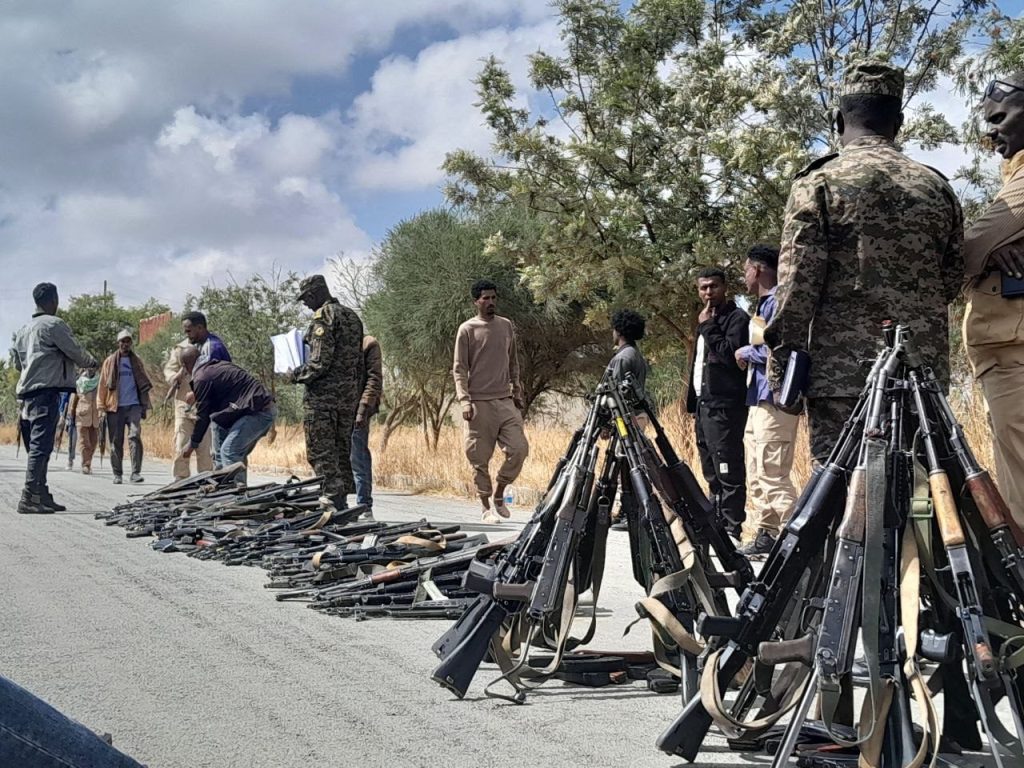Disarmament, demobilisation and reintegration (DDR) can be both a mechanical process of transforming former fighters into civilian roles; and a strategic process to help create stability and prosperity in a post-conflict society. In Tigray, this strategic outcome would also contribute to Ethiopian national stability and security, as well as regional stability.
The DDR process is an integrated suite of interventions that only bear full fruit when delivered together. Disarmament reduces the immediate insecurity of a post-conflict society by removing weapons. Demobilisation stabilises society by reducing the size of a standing military or paramilitary force, cutting the cost of supporting it and redirecting resources to individuals and communities. Reintegration supports wider normalisation in society, cementing the temporary effects of disarmament and demobilisation.
DDR, whether seen as a mechanical process or a strategic effect, demands political will, state capability, and integrated planning and delivery. Without shared political will, it’s vulnerable to malign actors and lacks a defined goal. Without state capability, a large, complex task requiring society-wide effort can fail. Without integrated planning and delivery, including learning what works and what doesn’t, misplaced assumptions can undermine the strategic purpose.
Tigray
The DDR process in Tigray has suffered failures at all levels.
Although it is fair to say that most former fighters have been disarmed, where those weapons are now stored and under whose control (and for what purpose) is unclear. It is certainly not the case that they have been placed verifiably beyond future use.
A portion of the 274,000 former fighters have been demobilised. The initial demobilisation of about 75,000 has been underway for some time, but funding for more than this is uncertain. The process has yet to address the remaining former fighters who could still fight if called upon.
Finally, there are no resources available to support reintegration. The individual demobilisation grant is now devaluing, and there are no funds for services to returning individuals or the communities that will receive them. The process then lacks the glue that binds it together.
The reasons for these weaknesses are well known.
Political will. The Pretoria Cessation of Hostilities Agreement (COHA) established a ceasefire but failed to address a future political settlement for Tigray or a process for achieving it. Consequently, the stop-start DDR process in Tigray has become a competition for control of the threat of force between factions of the Tigray People’s Liberation Front (TPLF), which has split along ideological, economic, and geo-strategic lines. The interests of the civilian population, still recovering from the trauma of the conflict, seem to have been entirely overlooked.
State capability. The Tigray Interim Regional Administration (TIRA), established after COHA to oversee a transition including towards future elections, inherited a fundamentally broken state. The fighting between the TPLF and the Ethiopian National Defence Force (ENDF) and its ally, the Eritrean Armed Forces, exacerbated the physical damage. But beyond broken infrastructure and looted coffers, TIRA lacked the human capital and the institutional capability to plan, direct, oversee, and implement a reintegration support strategy.
Delivery and learning. The lack of state capability drives the inability to translate vision and plan into effective action. This weakness is further compounded by the lack of political will. Many decision-makers, including those in Tigray, rely on outdated ideas and approaches. In the past, Tigray was a conformist, largely rural, and centrally led society. This has led to assumptions about the needs and aspirations of a new generation of former fighters and their communities that are at odds with reality. Tigray’s political leadership, apparently prioritising internecine rivalry over societal delivery, neither understands the Tigray of today nor is open to alternative perspectives based on learning about what works and what does not.
Tigray rules football
These factors have led to a game of Tigray rules football (akin to Australian rules football which is an extreme form of soccer), where the DDR process, along with similar processes requiring discussion, negotiation, and will, has become a battleground for relevance and self-interest among the political elite. Process and people are the immediate victims, but Ethiopian and regional stability and security are likely future victims too.
Following what amounted to an internal coup in March 2025, the faction of the TPLF which led TIRA was ousted by its more ideologically driven former comrades. Left with the problem of what to do, the Federal Government – which holds the responsibility to mandate and appoint TIRA – appeared to pause.
What under other circumstances might have been a little local difficulty is in fact a much more complex set of tensions. Addis Ababa had a number of options – none of which were good. It could require a limping and limpid administration to continue on its ineffective course; or it could hand the problem of delivery to TIRA’s harshest critics, the more ideological wing of the TPLF. Neither course was attractive – the TPLF (specifically and generally) is a shadow of its former self and has alienated a lot of people in Tigray. One – ideological – faction of it has also aligned itself with Ethiopia’s newly re-minted enemy Eritrea which inconveniently still has forces stationed inside the region. And there were other wicked problems remaining, such as the presence of ethnic Amhara aligned militia in western Tigray and the presence of Eritrean troops along the northern border.
Faced with no good options, Addis Ababa opted for a proven approach from the toolkit of the past: appointing a capable military leader. They believed this would ensure the TPLF felt represented by someone with a broader military appeal, and the leadership skills of a general would help focus everyone on the need for swift action.
Following the appointment of the former Tigray Defence Forces (TDF) General, the more ideologically aligned wing of the TPLF initially felt it had ‘won’ this latest skirmish not just with Addis but with the rest of the movement. They believed the General could be relied upon to follow the party line. However, early signs suggest that willingness to follow direction may not be the new regional President’s biggest challenge. The same fundamental flaws in the process remain and will likely become flash points again.
And this is compounded by curios form of contract which the new President signed – to much fanfare – when he was appointed by Addis Ababa. The eight point To Do list was a concise summary of the fundamental challenges which remain today but which are rooted in the past and which were compounded by the civil war. And this challenge is further deepened by a requirement to address them all before the 2026 elections. Superficially the To Do list is full of process. But the obstacles to progress in any of them remains the absence of political will, with lack of TIRA capability a close runner up.
Back to the future
Early signs are not encouraging. The leadership of the now vanquished faction of the TPLF have gone to ground – some in Addis Ababa where they have accepted posts with the Federal government; some outside the country. The new President, perhaps betraying a mistaken assumption that military credibility would translate into bureaucratic competence – has appointed a workman-like cabinet (albeit one with a distinct political leaning towards the more ideological wing of the TPLF). But he appears unable to impose his will on it, let alone manage it. And the now victorious (and crowing) wing of the TPLF has openly established channels of communication with Eritrea, including inviting senior officials from Asmara to visit Tigray.
Tigray’s future looks uncertain again. It will require extraordinary luck and fortune to navigate the pathway to the elections and beyond. The conditions for DDR, the return of internally displaced people, and the extension of government to Tigray’s occupied areas are absent. The economy is shrinking, and Ethiopia and Eritrea are taunting each other about access to the Red Sea. A younger, Tigrayan militia opposed to the TPLF’s ideological wing is also forming and arming in Afar.
Perhaps a failure to deliver on the President’s To Do list before the next elections is not the most immediate security and conflict challenge which confronts the people and politicians of the Tigray, Ethiopia and the region.
While Addis Ababa may in fact have chosen to give the hardline TPLF faction enough rope to hang itself, a future return to conflict will be even bloodier and more destructive, requiring greater effort to address its humanitarian, national and regional consequences.
Whilst it is unclear what to actually do to make things better, there is still scope to help make things less bad. A DDR programme is not a substitute for political engagement. Just talking to the new TIRA about its plans and how they are being implemented, and looking engaged and hands-on, would be a good posture for the international community.
But watching and waiting for failure – arguably the path of least resistance – is a concrete investment in future chaos and conflict. Politically and strategically, but also for the sake of the people, this outcome must be avoided.


Leave A Comment